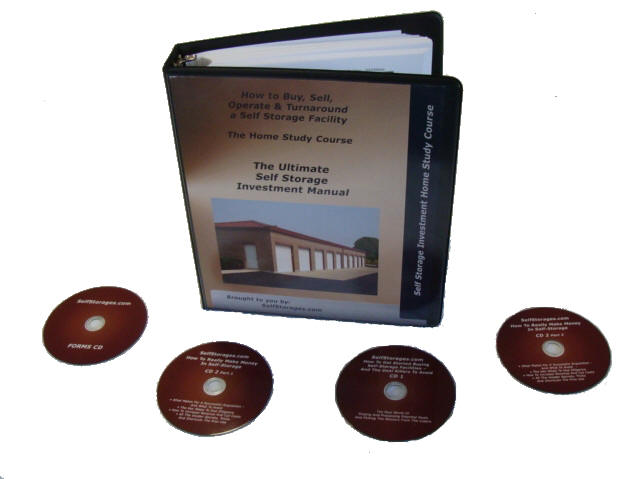A prominent hedge fund manager recently announced that the only form of real estate that they have confidence in is self-storage. The reason? They felt that the accumulation of material objects is such a strong desire of most Americans that they will continue on regardless of the economy. Essentially, self-storage has evolved from a luxury to a necessity. I remember back when not that many people had self-storage units, and most of them had units just to store their seasonal decorations. Today, a huge number of Americans -- more than 10% of American households – rent a storage unit. That’s over 30 million people. And they use them to warehouse more than just Christmas ornaments. Storage units have become the norm for people who are moving, downsizing – just about any activity that causes an upheaval in life. The big question is how Americans ever survived without self-storage? Hard to imagine today.
Memo From Frank & Dave
How To Make A Million Dollars With A Self-Storage Facility

The top 10% of Americans have a net worth of $1 million or more. So how can a single self-storage facility propel someone to millionaire status. The answer is: pretty easily if you buy the right property at the right price. There is a systematic way to make money in self-storage, and understanding those key drivers is essential to hit the goal of a million dollar profit.
Understand the drivers to profitability
Self-storage is not a very complicated business model. Like any business, there are certain components that yield success. At its most basic level, a self-storage facility needs to bring in more revenue than it spends out in expenses. But there is much more than that to a winning formula.
Good due diligence
Benjamin Franklin once said “diligence is the mother of good luck”. He was not talking about self-storage facilities, but he could have been. We have found that every successful storage deal begins with great due diligence. “Due diligence” refers to a systematic checking out of every aspect of the property, from confirming the number of occupied units and rent, to verifying all the costs, as well as the property condition, market dynamics, and operating permits. You can’t make money if the facility is doomed to failure due to faults that you have not detected.
Good economics
Sure, it sound ridiculous, but some people miss the whole concept of buying storage facilities that have good economics. They horribly overpay just because the broker told them “this deal will be worth a fortune someday”. You can’t buy a property for more than it’s worth right now and get anywhere with it. Buying real estate may seem exciting, but overpaying for it certainly is never a good idea. Self-storage facilities should be rated based on the “cap” rate and the “cash-on-cash” return. If you don’t know these, then you still don’t know enough about that property. The general rule is to buy at a 8% to 10% cap rate and generate around a 20% cash-on-cash return.
Leverage
All forms of real estate demand leverage (bank financing) to hit their highest yields. To make significant money, you will need to leverage what you buy. Sensible leverage is about 70% to 80% of appraised value (which is typically defined as what you are paying for it). You cannot normally make big money in real estate without debt.
Raise revenue beyond initial levels
So now let’s get down to the nuts and bolts of making a million dollars with a storage facility. Assume you are buying a property with a 9% cap rate, and a loan at a 6% interest rate. And let’s assume that you are financing it at 80% loan-to-value. As long as the property can cover that mortgage with a fair amount of safety cushion, then that’s great, but that’s not the whole story of how to make money. What’s important to making big money is the ability to great increase the revenue. You do this by increasing occupancy and enacting higher monthly rents. So that means you have to buy a property that has a fair amount of vacancy, under-market rents, and the ability to increase both through better marketing and better managed affairs.
The power of cap rates
OK, here’s the secret to making a million dollars with a self-storage facility. Simply increase the revenue by around $7,000 per month. Since your costs are already fixed, that will give you an increase in net income of $84,000 per year and, at an 8% cap rate, an increase in value of over $1 million (take $84,000 and divide by the cap rate of .08). To increase the revenue by $7,000 per month, assuming $100 per month unit rents, means that you’d have to rent 70 more units than the former owner. But let’s also assume that the former owner has 150 rented at $80 per month, and you raise those to $100 per month – that has already taken you half the way to your goal, for a total revenue bump of $36,000 right off the bat. That means you only have to rent 35 more units – and that’s not that hard.
Conclusion
Can you make a million dollars with a self-storage facility? Yes. Can you do this using a not-that-risky method that real estate investors have used for decades? Yes. Why aren’t you already doing this? That’s yours to answer.
Self Storage Home Study Course
Our Home Study Course is not like anything you have ever listened to or read before. We do not fill it with a bunch of fluff on how your are going to make a million bucks with no money down. We tell you the whole story... the good, the bad, and the sometimes ugly.
Click Here for more information.
How To Make Your Self-Storage Debt As Secure As Possible

Nobody smart likes risk. But it’s all around us every day, from the minute we pull out of the driveway to when we get back home. The key to risk is to mitigate it – reduce it – as much as possible using sensible methods to do so. When it comes to debt, there are several strategies that are very effective.
Keep debt long term
You should always keep your debt “long term”. That means that there is a huge span between right now and when the note comes due. That’s because one of the biggest risks of debt is simply replacing it when the note comes due. Most storage facilities are sold on a 30-year amortization – which means that you pay off the mortgage in 30 years. But the “term” of those notes is normally around 10 years or less, which means that you will have to obtain a mortgage on that facility three times before it is paid off. That means three banks (unless the same bank renews it), three loan committees, and three signings of loan documents. Short term loans require must more frequent – and risky – obtaining of new mortgages. Your house may be on a fully-amortizing 30-year loan, but that just is not what you’ll find in the commercial loan market. A long term loan means you’ll get more years of safety before you have to find a new loan. Why is finding a new loan a problem? It’s not, except in those cases when the lending market is in turmoil. But even if the loan market is healthy, its nerve racking to obtain a new loan, as well as expensive to obtain new appraisal, property condition reports and pay points and legal fees. If you have two loan options – a ten year and a five year – always go with the longest term.
Fixed interest rates
Interest rates are cyclical. They go up and down, and have for hundreds of years. The only thing that’s certain about interest rates is that nobody can realistically predict them. As a result, you don’t want to get in a bind and let the interest rate on your loan go up without fighting as hard as you can to prevent it. The only safe way to limit interest rate exposure is to use “fixed rate” loans. A “fixed rate” loan means that the interest rate does not ever change for the life of the loan. The other option is a “floating” or “variable rate” loan, in which the interest rate can change at any time based on the prevailing U.S. interest rates. Some banks want to entice you into a “variable rate” loan by offering you a lower rate going in. For example, right now a fixed rate loan might be at 5%, while a variable rate might have a 3.5% teaser rate to get you to choose it. Don’t be fooled. A fixed rate loan is always superior, if you are trying to hedge risk. Just ask those folks who had variable rate loans in the days of Ronald Reagan, when interest rates shot to 14% virtually overnight.
Non-recourse
“Non-recourse” debt means that, in the event that your deal goes bad and you can’t repay the mortgage, the bank cannot come after you for the loss. A “recourse” loan means that they can. While it’s rare for a self-storage loan to go into default – in fact, it has the lowest default rate of any type of real estate in the U.S. – it is still a risk, and you need to hedge all risks if you’re a smart investor. If you have two loans to choose from, then always go with the non-recourse option.
Stay away from non-traditional debt types
Most of the financing types out there are traditional banks are bank derivatives, such as CMBS “conduit” debt. However, there is also another form called “hard money” which is not associated with traditional lending. Stay away from this type of borrowing. While banks are regulated by the U.S. government, these “hard money” lenders are not. Additionally, without that oversight, many of them are not really in the banking business but in the “loan to own” business. What that means is that they are actually hoping you don’t make your payments, because they want to foreclose and keep your 20% down payment. While there are certainly some legitimate hard money lenders out there, we have heard many more nightmare stories than good reviews. Stick with real lenders that are under the supervision of the U.S. government.
Conclusion
There’s risk in everything. But don’t let that stop you from having a successful investing career. You definitely can reduce your risk when it comes to mortgages, if you play it smart.
Why A Free Drink Is A Great Start In Securing That Lease

A big part of the American culture is a refreshing beverage. The old slogan “a Coke and a Smile” is true – most people seem to have a happier frame of mind when they are offered a free drink. So use that same sales logic in your office. When a customer is looking at renting a unit, offer them a free drink. Keep some bottled waters and a selection of soft drinks in a small refrigerator. You’ll be surprised at the net effect. Dollar for dollar, offering a free drink is one of the most effective sales tools out there.
New Facilities for Sale on SelfStorages.com
Brought To You By SelfStoragesUniversity.com
If you need more information please call us (855) 879-2738 or Email [email protected]
